Arizona’s diverse landscapes are a collage of color, life, and rock—proof that nature is the ultimate artist. The arid expanses of the desert, punctuated by geological marvels and robust ecosystems, offer tourists not just picturesque views, but experiential odysseys. From the vastness of the Grand Canyon to the sky-piercing spires of Monument Valley, the Arizona desert is a cornucopia of wonders that enthrall visitors with its untamed beauty. This journey through the desert’s heart reveals how the arid reality is anything but barren—it thrums with life, its silence speaks volumes, and each wonder tells a tale of the earth’s deep past.
Unveiling the Mysteries of the Arizona Desert
The desert’s allure doesn’t solely rest in its ability to defy the harshness with a hidden tenacity for life; its true beauty lies in its embrace of extremities. The Arizona desert is a land of paradoxes. Its rugged terrain holds sensitive ecosystems, and its severe climate shelters delicate beauty. Boasting all four major North American deserts — the Sonoran, the Chihuahuan, the Mojave, and the Great Basin — Arizona enfolds a symphony of biodiversity and culture within its vast stretches. This backdrop sets the stage for our exploration of the five jaw-dropping wonders that make the Arizona desert a bucket-list destination for luxury travelers and nature enthusiasts alike.
A Natural History of the Sonoran Desert
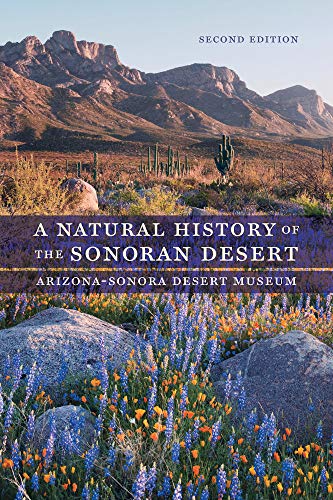
$25.49
**A Natural History of the Sonoran Desert**
“A Natural History of the Sonoran Desert” is a comprehensive guide that invites readers to explore the fascinating and diverse ecosystems of one of North America’s most vibrant deserts. This beautifully illustrated text delves into the unique biogeographic region that spans much of the southwestern United States and northwestern Mexico, providing insights into the complex web of life that thrives in this arid landscape. The book meticulously details the Sonoran Desert’s wide array of plant and animal species, from the iconic saguaro cactus to the elusive jaguar, bringing to light the adaptive strategies that enable them to flourish in such extreme conditions.
The second section of the book focuses on the ecology and geology of the desert, examining the geological forces that crafted this environment over millennia and the ecological interactions that sustain its rich biodiversity. Readers will discover the profound effects that water, in its limited and precious forms, exerts on desert life, shaping ecosystems in an intricate balance of survival and coexistence. Attention is given to the cycles of the desert, from monsoons that bring life-giving rains to the dry spells that impose seasons of scarcity, and how these cycles dictate the lives of the desert’s inhabitants.
In the final chapters, the book touches on the human history of the Sonoran Desert, from ancient indigenous cultures to modern conservation efforts. It emphasizes the importance of understanding and preserving this unique environment as it faces the challenges of climate change and human expansion. “A Natural History of the Sonoran Desert” is not just a field guide but an enlightening journey through one of Earth’s most extraordinary landscapes, sure to captivate naturalists, scientists, and laypersons alike with its rich narrative and inspiring call to appreciate and protect our natural world.
The Grand Canyon: Nature’s Masterpiece in the Arizona Desert
The Grand Canyon is a testament to the power and grandeur of nature’s artisanship. Carved by the persistent flow of the Colorado River over millions of years, the canyon showcases the results of time’s patience: layers upon layers of rock that tell the history of the earth itself. The geological significance of the Grand Canyon, complete with its immense scale, is the first thing that strikes visitors as they stand on the precipice of this iconic Arizona desert wonder.
Visitors can journey into this vast chasm in style — consider a fly high experience with a helicopter tour that provides unparalleled views of the canyon or walk out onto the transparent Skywalk that juts over the canyon’s edge. For those seeking a surge of adrenaline, white-water rafting down the Colorado River offers not just an alternative perspective but memories that cling tighter than the river’s spray. And as the sun dips low, the canyon walls bask in its glory, transforming into a canvas of changing hues.
The Grand Canyon is also a refuge for distinctive flora and fauna. A diverse array of creatures, like the California condor, make their home here, and many plants have adapted to thrive in this almost Martian landscape. Yet, amidst the raw beauty and harsh environs, the canyon retains a mystical tranquility that speaks directly to the soul.
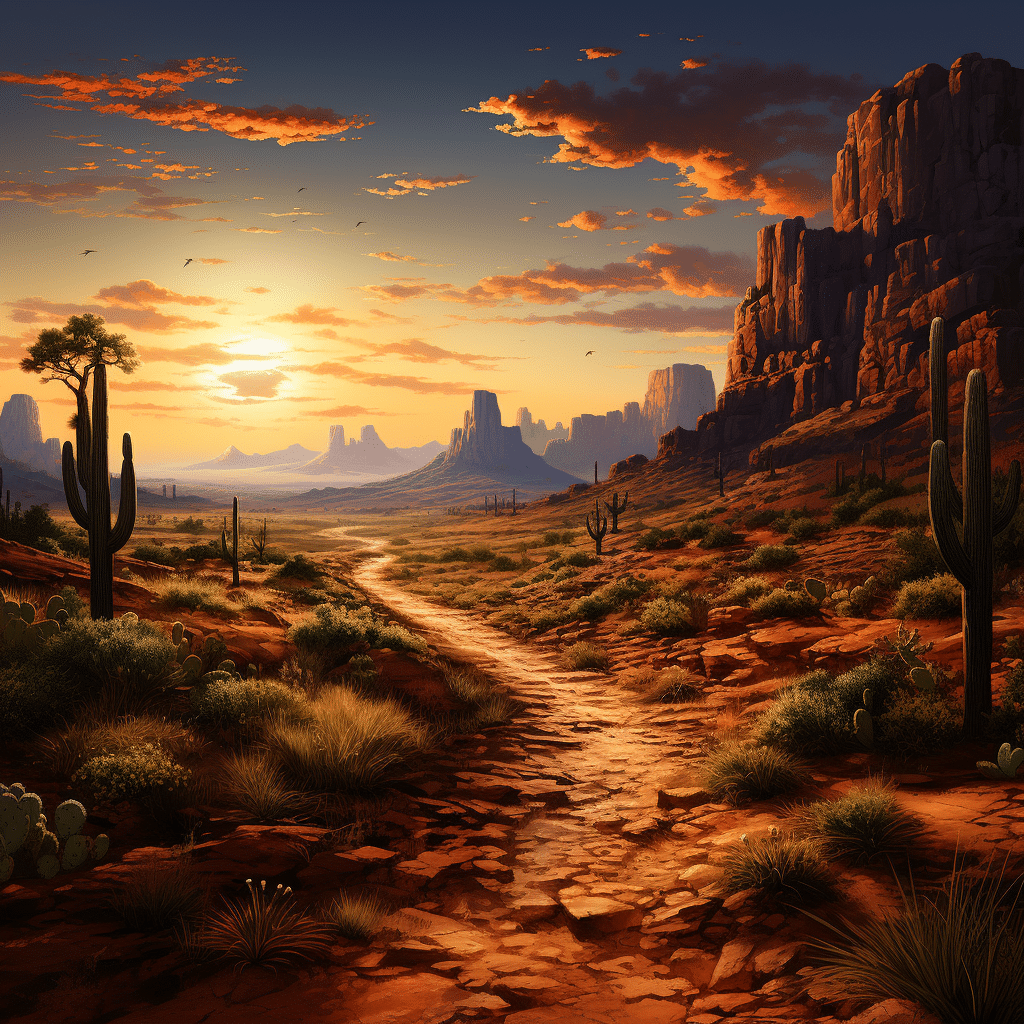
| Category | Sonoran Desert Characteristics |
|---|---|
| Location | Southwestern Arizona, southeastern California, Baja California, and Sonora, Mexico |
| Size | Covers an area of approximately 100,000 square miles |
| Climate | Arid subtropical. Hot summers with temperatures exceeding 40°C (104°F), often reaching 48°C (118°F). Violent summer monsoons |
| Precipitation | Infrequent and irregular, often less than 90 mm (approx. 3.5”) annually |
| Major Cities | Phoenix, Arizona (largest city, with a 2017 metro population of approx. 4.7 million) |
| Biodiversity | Rich spectrum of about 2,000 plant species, including legume trees and columnar cacti; diverse wildlife |
| Cultural Significance | Home to over 17 contemporary Native American tribes with reservations in the area |
| Environmental Concerns | Rapid urbanization leading to habitat destruction, changes in riparian areas, and water scarcity |
| Unique Flora and Food | Cacti fruit, beans, squash, corn, sunflower seeds, wild greens, chiles, mesquite pods, desert berries |
| Recreational Activities | Hiking, wildlife observation, photography, studying native petroglyphs |
| Conservation Efforts | Efforts are in place to protect the unique ecosystems and Native American cultural sites |
| Temperature Range | Warm year-round in lower-elevations |
| Native Tribes | Over 17 tribes with continuous cultural presence |
| Landscape Features | Cactus forests, rugged mountains, native petroglyphs |
| Distinction | Considered the most tropical desert in North America |
| Notable Plant Life Forms | Legume trees and columnar cacti (distinguishable from other North American deserts) |
| Accessibility | Several hours south from Grand Canyon National Park |
| Unique Characteristics | High biodiversity and notable tropical conditions compared to other North American deserts |
| Area in the United States | Southern third of Arizona, small areas in southeastern California |
| Area in Mexico | Baja California and the state of Sonora (more than two-thirds of the total area) |
Monument Valley: The Iconic Spires of the Arizona Desert
Journeying further into the heart of the Arizona desert, one encounters the majestic Monument Valley — an iconic symbol of the American West. These towering rock formations rise like ancient monuments, sculpted by the hands of time and the elements. The Valley holds a sacred place in Navajo culture and has captured the imagination of filmmakers and artists, becoming a recurring backdrop in Western movies. Notably, the Mittens and John Ford’s Point offer snapshots so familiar they feel like part of a collective memory.
For a journey through these iconic vistas, guided tours with native Navajo leaders afford a deeper understanding of the land and its stories. They narrate the cultural significance with a resonance that echoes against the red sandstone. And nothing beats the sight of these spires from a scenic drive at dawn, as their imposing silhouettes catch the first light of day.
Antelope Canyon: Arizona Desert’s Natural Sculpture Gallery
Antelope Canyon stands as nature’s sculpture gallery within the Arizona desert, where light and shadow dance across spiraling rock walls. Prized by photographers and nature enthusiasts, this slot canyon’s allure lies in the surreal, undulating forms and the way sunlight sneaks into its depths, creating radiant beams that play with the colors of the sandstone.
The ethereal beauty of Antelope Canyon is available to visitors through guided tours only, and the experience is akin to exploring a sacred temple, with a reverence for the land that is palpable in the hushed tones and careful steps of those traversing its corridors. The Upper and Lower sections of the canyon both offer unique perspectives, with the play of light shifting throughout the day, crafting a visual symphony that leaves one in awe.
Foraging Arizona Finding, Identifying, and Preparing Edible Wild Foods in Arizona (Foraging Series)

$17.99
“Foraging Arizona: Finding, Identifying, and Preparing Edible Wild Foods in Arizona” is an indispensable guide for nature enthusiasts and culinary adventurers alike. Written as a part of an esteemed Foraging Series, this comprehensive resource offers a dive into the diverse landscape of Arizona, revealing the rich bounty of edible wild plants that thrive across its deserts, canyons, and forests. Readers will learn how to safely identify, harvest, and use a variety of native plants, all while gaining a deeper appreciation for the state’s natural ecology.
Each section of the book is meticulously organized with detailed descriptions and clear, color photographs to ensure successful foraging. It covers a wide array of plants, from the well-known prickly pear cacti to the less common desert wildflowers, taking into account the unique growing seasons and habitats of Arizona’s flora. Beyond identification, the book provides practical advice on sustainable foraging practices, emphasizing the importance of preserving the environment for future generations.
What sets this guide apart is its extensive coverage on preparation methods, turning foraged finds into delicious meals and snacks. It features an array of recipes that cater to a variety of diets and culinary preferences, ensuring that every forager can enjoy the fruits of their labor. Whether you’re a novice forager or a seasoned wild food aficionado, “Foraging Arizona” offers a thorough and enjoyable exploration of foraging in the Grand Canyon State, delivering a perfect blend of education and epicurean delight.
Saguaro National Park: A Forest of Giants in the Arizona Desert
Amidst the sun-scorched land of the Sonoran Desert, there stands a forest unlike any other — Saguaro National Park, named for the towering saguaro cacti that define its landscape. These sentinels of the desert, reaching skyward with arms outstretched, are emblematic of the American Southwest and hold a unique position in the ecosystem.
In the park’s two distinct sectors, the Rincon Mountain District and the Tucson Mountain District, visitors may explore a wealth of trails that offer glimpses of the desert’s ecosystem in which these giants are central characters. From the might of mature saguaros that have weathered a hundred summers to the delicate blossoms that cap their limbs, this national park tells the story of resilience and adaptation.
The saguaro’s lifecycle underpins a diversity of wildlife — from Gila monsters to the elusive desert bighorn sheep — and is especially wondrous when the desert blooms with colorful wildflowers and cacti show off their spring finery. The best times for visitors to witness this floral spectacle are during the cooler, more temperate shoulder seasons.
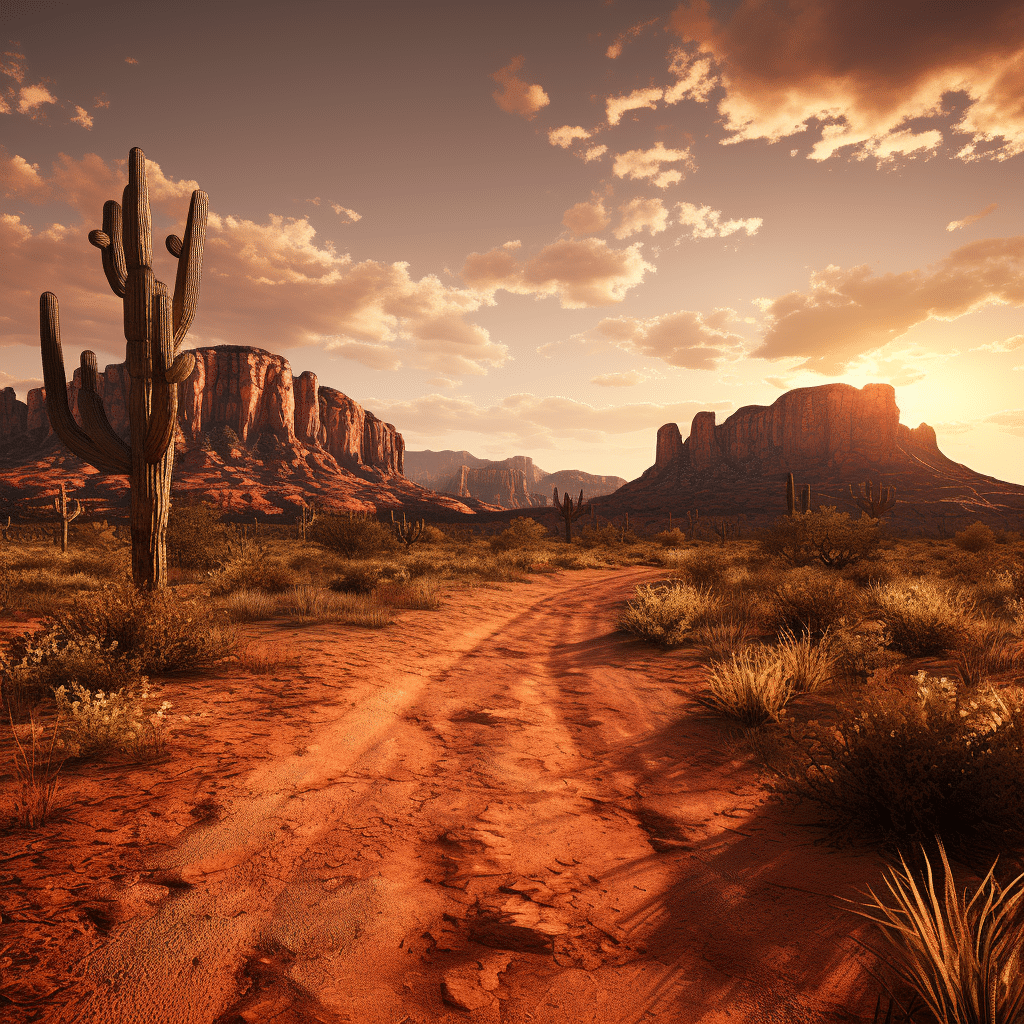
Sedona’s Red Rock Country: The Vibrant Artistry of the Arizona Desert
Concluding our list is Sedona, where the red rock spires and buttes blaze with color at the day’s golden hours. The geological drama of Sedona’s Red Rock Country is like stepping into a painted masterpiece, with landmarks such as Cathedral Rock and Bell Rock serving as natural testimonials to the forces that shaped this landscape.
But there’s something more to Sedona than its stunning vistas; it’s a place where the spiritual and the earthly commune, purportedly amplified by energy vortexes. This Arizona desert wonder is not only a visual feast for photographers and tourists but also has become a nexus for those seeking introspection and renewal.
Leveraging the land’s energy and beauty, visitors can embark on journeys into self, from hiking and exploring on Jeep tours to gaining a bird’s-eye view of the splendor from a hot air balloon. Whether you’re grounding your spirit among the red rocks or soaring above, Sedona offers transformative vistas.
Conclusion: The Enduring Allure of the Arizona Desert
The Arizona desert is more than a featureless stretch of sand; it is a landscape that defies easy categorization — a tableau that changes from moment to moment, inviting visitors to pause and ponder. The combination of these five wonders of nature — each distinct yet interconnected — exemplifies the enduring allure of the desert.
MasterPieces Piece Jigsaw Puzzle for Adults, Family, Or Kids Cacti of The Desert Southwest x
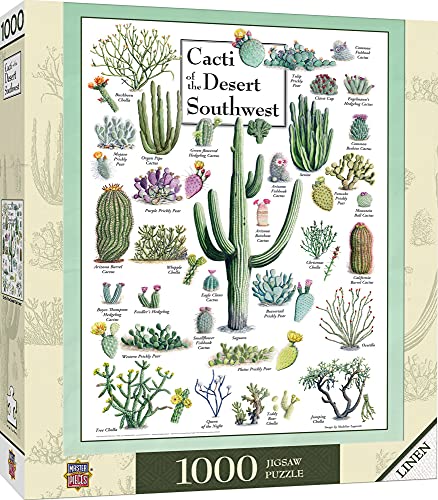
$16.99
The MasterPieces Piece Jigsaw Puzzle is a captivating and challenging puzzle designed for adults, families, or kids who have a passion for the flora and intrigue of the desert southwest. This jigsaw offers an array of vibrant and detailed images of various cacti set in a stunning desert landscape, spanning a generous dimension of x inches when fully assembled. With intricately designed pieces that perfectly interlock, the high-quality puzzle is both stimulating and satisfying to complete, making it a perfect activity for quiet afternoons or family game nights.
Every piece of this premium puzzle is crafted with precision and care, ensuring a snug fit and an impressive display of the desert’s natural beauty upon completion. The lifelike illustrations underscore the diversity of cacti species found in the arid regions of the southwest, featuring everything from the iconic Saguaro to the delicate blooms of the Prickly Pear. Additionally, the sturdy box and fade-resistant inks guarantee that this jigsaw can be assembled time and time again, making it a lasting addition to your puzzle collection.
Not only is the MasterPieces Piece Jigsaw Puzzle a great way to unwind and challenge your cognitive skills, it’s also an educational experience that brings the wonders of the desert into your home. As puzzlers piece together each cactus against the backdrop of a sinking sun, they’ll deepen their appreciation for these resilient plants and the ecosystems they inhabit. Whether it’s a gift for a puzzle enthusiast or a new hobby for yourself, this jigsaw puzzle serves as an immersive journey to the enchanting landscapes of the Desert Southwest.
As we have journeyed through these stunning locales, the imperative to conserve and cherish these landscapes becomes apparent. The desert’s puzzles and enigmas continue to captivate, but their preservation is incumbent upon us all. Visitors arrive seeking beauty and leave as stewards of an irreplaceable heritage. So, come to Arizona, where the sands are alive, and the rocks tell tales — embark on that transformative journey and discover the desert’s profound serenity and wonder. Fly high on the wings of adventure and let the Arizona desert change you, as it has so many before.
Unveiling the Wonders of the Arizona Desert
The Arizona desert is not your average sandbox. Oh no, sirree—it’s a sprawling, sun-soaked canvas of natural marvels that’ll knock your socks off or, better yet, fill ’em with sand. Let’s take a wild ride through trivia and fun facts that highlight five jaw-dropping wonders hiding in plain sight across this arid paradise.
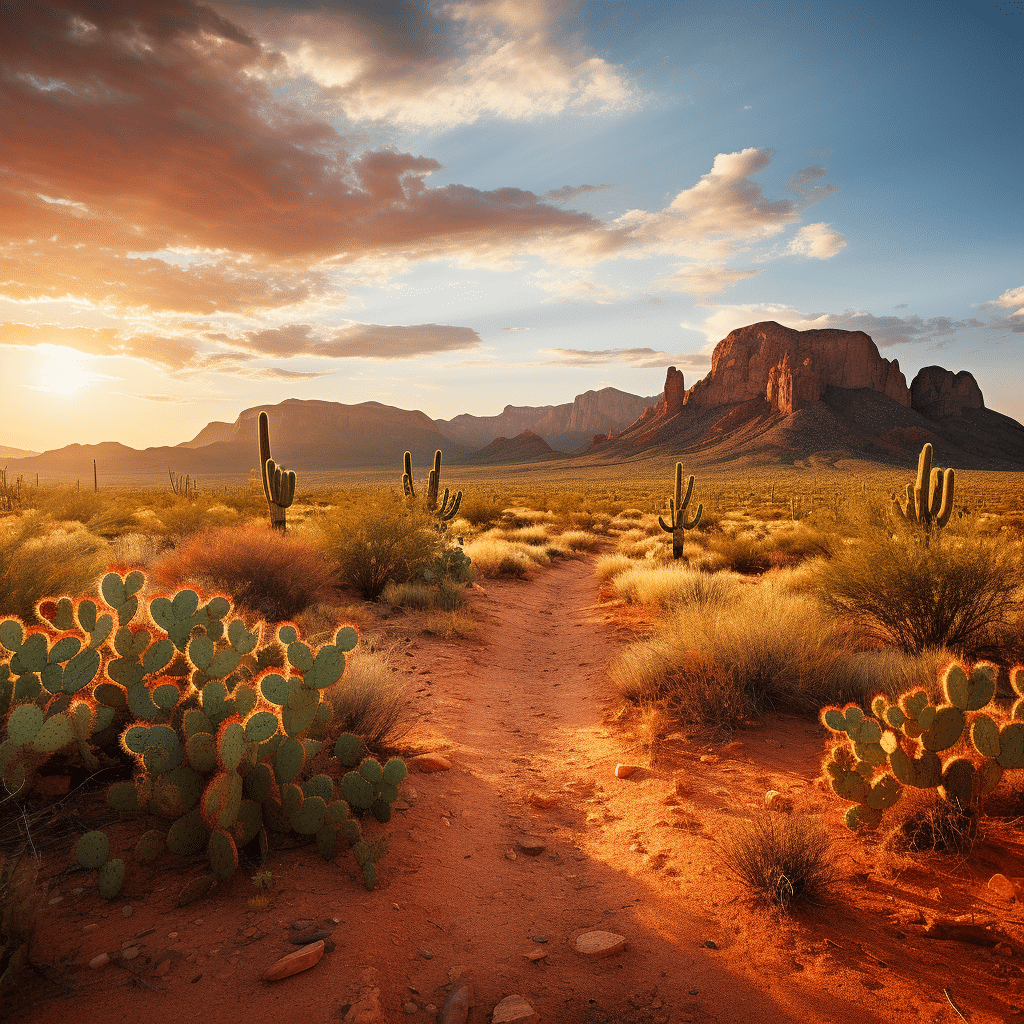
1. The Grandest Canyon of Them All
You can’t chat about the Arizona desert without tipping your hat to the granddaddy of natural wonders: the Grand Canyon. Get this—a whopping 5 million folks visit each year. But did you know if you stacked up four Empire State Buildings, they’d still be winking up at the rim from the canyon’s depths? As deep as your love for “Hotel Catalina” may be, it’s got nothing on the depth of the Grand Canyon, just sayin’. Now, imagine unwinding at a place with views as breathtaking as the canyon itself. It’s not just a pipe dream! You can truly kick back at the Hotel Catalina after a day of adoring this massive marvel.
2. Cacti That Tower Like Skyscrapers
The Saguaro cactus is as iconic to the Arizona desert as memes are to the internet—you just can’t imagine one without the other. These prickly green giants want to see what’s up, growing to more than 40 feet tall! That’s like, “look at me, I’m the captain now” tall. And for the green-thumbed fun fact fans: a Saguaro cactus doesn’t sprout arms until they’re in their 70s. Patience, much? It’s like waiting for the next hilarious meme compilation to drop.
3. A Crater Not Made for Swimming
Meteor Crater, or as the nerd squad calls it, Barringer Crater, is a roadside stop that’s literally out of this world. This 50,000-year-old impact site gives a whole new meaning to making an entrance. Did you know it’s so colossal you could toss 20 football games simultaneously inside it? Forget touchdowns; this is stellar! If you’re gunning for impact, ready for a change of scenery as drastic as m 367 hits your life, the Meteor Crater should be your next pit-stop. And speaking of impact, catch up on the substance that left quite a mark at M 367.
4. Spelunking in the Colossal Cave
Colossal Cave is a subterranean spectacle that offers a cool respite from the scorching Arizona desert sun. Think underground mazes with awe-inspiring limestone formations and a history rich enough to rival Stephanie Corneliussens acting career. You could lose yourself (in a good way) in these winding paths. They’re packed with local legends, and some say they’re still hiding treasures! While we’re on the subject of treasures, Stephanie Corneliussen’s performances are undoubtedly gems to behold. Dive deep into her career at Stephanie Corneliussen.
5. The Musical Rocks of The Wave
And for something that’s music for your eyes, there’s The Wave—an undulating sandstone rock formation that’s every photographer’s dream. Its psychedelic colors and trippy curves look like they’re straight from the backdrop of an Rbd tour. Their fans would feel right at home here, enjoying the grooves and ripples that look like they’re frozen in time. Speaking of concerts, don’t miss out on info about the next big RBD tour( to get your fix of musical magic.
Well, Ain’t That Something?
There you have it, folks. Five jaw-droppers in the Arizona desert that you won’t find anywhere else. And hey, I know we’d all hate for any of these wonders to go missing like Drake Bell that one time. Can you imagine the confusion? We’d need an army of detectives on the ground. If you enjoy a good mystery, grab a magnifying glass and join the search for the full story at Drake Bell Missing.
So whether you’re saddling up for a high-octane adventure or simply browsing facts to flex at your next trivia night, remember, the Arizona desert is more than just a stretch of dry land—it’s a symphony of nature’s best hits.
What are the 4 deserts in Arizona?
Well, buckle up, desert adventurers! Arizona’s got its fair share of sandy spectacles, boasting not one but four major deserts: the Great Basin, Mojave, Chihuahuan, and the most famous of the bunch, the Sonoran Desert. Talk about a sun-baked quartet!
What is Arizona’s famous desert?
Arizona takes its deserts seriously, but the star of the show has gotta be the Sonoran Desert. It’s like the Grand Canyon of deserts – widely known and impossible to overlook!
What desert is near Phoenix Arizona?
Phoenix has cozied up to the Sonoran Desert, making it a next-door neighbor to Arizona’s claim-to-fame arid wonderland. So, when you’re in Phoenix, you’re in the thick of cactus country!
How much of Arizona is a desert?
Hold onto your water bottles, folks – an expansive 33% of Arizona is decked out in desert duds. So, yeah, that’s a whole lot of cacti and sunsets!
What is the most beautiful desert in the world Arizona?
Whispered on the winds and echoing through the canyons, the Sonoran Desert is often hailed as the world’s most beautiful desert. With its iconic saguaro cacti standing guard, it’s easy to see why it takes the global cake (or should we say ‘sand’wich?).
Is Flagstaff AZ a desert?
Flagstaff might throw you for a loop – it’s not a desert city at all! Parked at a lofty altitude, it’s more about alpine forests and snow than sand and saguaros.
What desert is Sedona in?
Sedona’s red rocks and mystical vibes are hugged by multiple ecosystems, including the high desert plateau characteristic of the Colorado Plateau region – not a specific desert, but desert-like no less!
What is the colorful desert in Arizona?
Get your cameras ready! The Painted Desert is the colorful gem of Arizona, flaunting a kaleidoscope of vibrant rock layers that’ll have you thinking Mother Nature’s been dabbling in art.
What desert is in Tucson?
Slap on some sunscreen, because Tucson is smack dab in the heart of the Sonoran Desert. It’s like the desert decided to give the city a big, sandy hug!
Is Scottsdale a desert?
Scottsdale might be a desert dweller’s dream with its posh amenities, but yep, it’s desert through and through – the Sonoran Desert, to be exact. Time to swap those high heels for hiking boots!
What desert is Phoenix known for?
Phoenix is not just a bustling metropolis; it’s the poster child for the Sonoran Desert – renowned for its extreme temperatures and remarkable flora.
Is Phoenix still a desert?
Sure, Phoenix has its fair share of pools and golf courses, but make no mistake, it’s still a desert all right, with the Sonoran sands stretching far and wide.
How much of Arizona is white?
Whew, talk about a loaded question! When we talk about Arizona being “white,” we’re not talking about snow-capped peaks or endless salt flats. Instead, we’re likely discussing demographic statistics. For natural landscapes, Arizona is much more about the reds, browns, and greens of its desert terrain.
Why did Arizona become a desert?
Arizona’s desert creds didn’t happen overnight. It’s been a long, hot minute (millions of years, actually) involving receding seas, volcanic activity, and drastic climate swings. Mother Nature’s the boss, and she decided desert chic was Arizona’s thing.
What state has the most desert?
Envy’s a sin, but other states might be green as a cactus with envy since California wins the prize for housing the most desert land in the United States, thanks to the Mojave and Colorado Deserts.
What is the difference between the Sonoran Desert and the Mojave Desert?
Talk about two peas in a pod that couldn’t be more different! The Sonoran Desert is your go-to spot for lush desert experiences, boasting rainy seasons and those towering saguaros. On the flip side, the Mojave’s a bit more on the down-low, drier and sporting the famous Joshua trees.
What are four 4 deserts found in the southwest?
Look southwest, and you might just see them waving – the four deserts, Great Basin, Mojave, Chihuahuan, and Sonoran, all sprawled out like a natural treasure map in the Southwest USA.
What are the 4 types of desert?
When we chat about deserts, we’re usually gabbing about the four main types: subtropical (think hot, hot, hot), cold (deserts in fleece jackets), coastal (beaches without the ocean), and rain shadow (living in the weather’s blind spot).
Where are the 4 deserts located?
If it’s deserts you’re after, just whip out a map of the Southwestern United States! The four deserts – Great Basin, Mojave, Chihuahuan, and Sonoran – are scattered across this sun-toasted region like sprinkles on a giant, dry sundae.
























